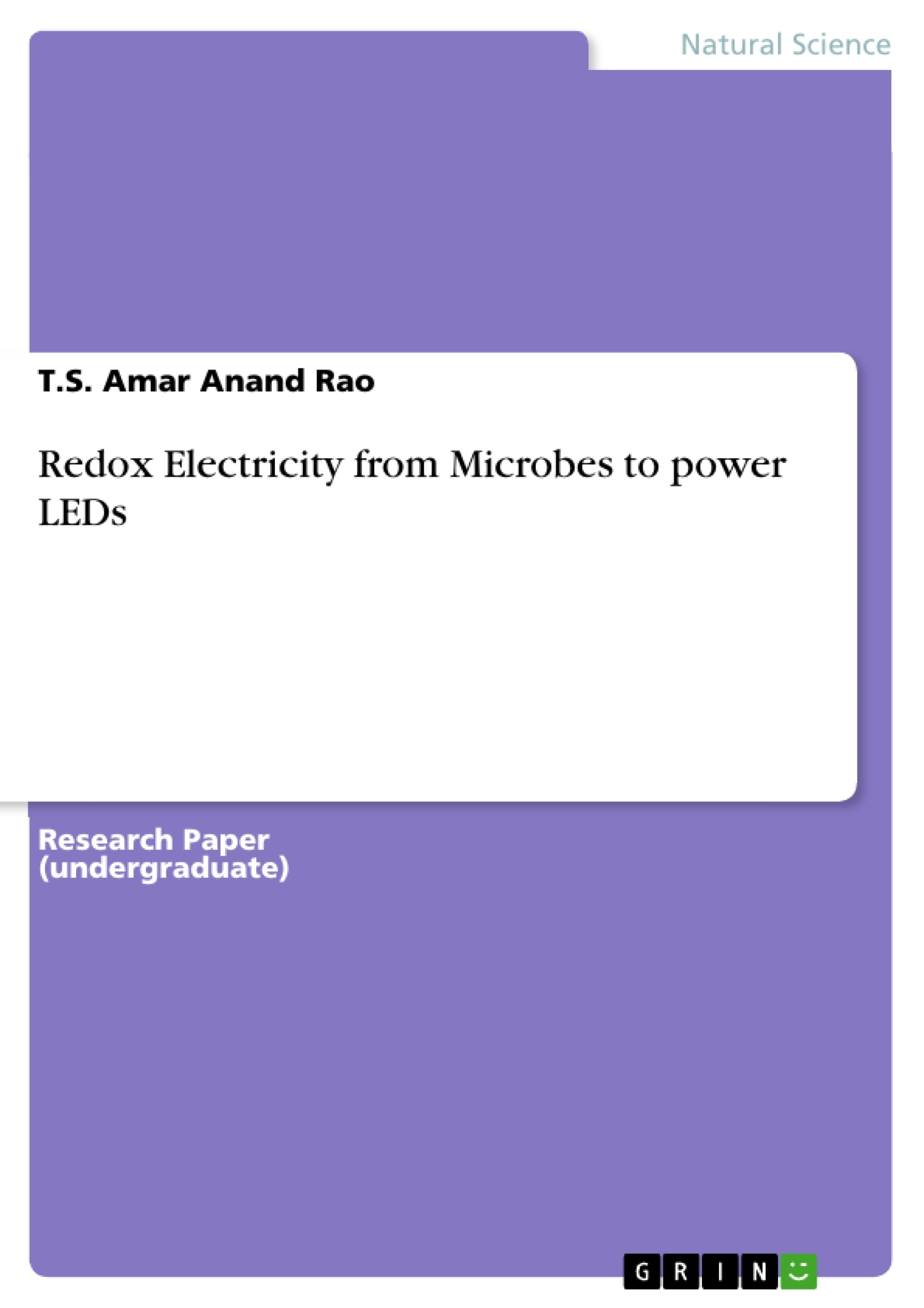Biogeochemical cycling through microbial succession in Winogradsky columns generates electricity. Here we use all electricals tools possible to harness this electricity and power Light Emitting Diodes for a year or more. The setup, biochemical mechanisms are analysed.
Table of Contents
- Abstract
- Introduction
- Microbial Fuel Cells (MFC)
- Materials and Methods
Objectives and Key Themes
The objective of this work is to demonstrate the feasibility of harnessing electricity generated by microbial activity in a Winogradsky column to power light-emitting diodes (LEDs). The research explores the biochemical mechanisms involved and analyzes the setup for long-term power generation.
- Harnessing Microbial Electricity
- Biochemical Mechanisms of Microbial Electrogenesis
- Development and Optimization of Microbial Fuel Cells (MFCs)
- Long-Term Power Generation from Microbial Sources
- Practical Applications of Microbial Fuel Cells
Chapter Summaries
Abstract: This abstract summarizes the research, highlighting the generation of electricity from microbial succession in Winogradsky columns and its application to power LEDs for extended periods. The setup and biochemical mechanisms are briefly discussed.
Introduction: This chapter introduces the concept of electricity generation from microbial activity in Winogradsky columns. It explores the oxidation and reduction of iron ions by bacteria, leading to an imbalance of electrons and the subsequent generation of an electric potential. The chapter highlights the use of voltage meters and ammeters to measure these changes and underscores the crucial role of pH in optimal biofilm performance, citing research by Susann Müller et al. (2011) which demonstrates the narrow pH window (6-9) conducive to effective biofilm growth and current production.
Microbial Fuel Cells (MFC): This chapter details the construction and operation of a microbial fuel cell (MFC) using a highly active Winogradsky column. It describes the methodology adopted, referencing the work of Josh McCready and Tess Edmonds, while noting modifications based on material availability. The chapter highlights observations like the gradual increase in voltage over time and mentions the daily cyclical activity of the microbes, indicating natural rhythms of activity. It emphasizes the simplicity of the chosen design, making it suitable for educational purposes, particularly for younger audiences. The chapter also mentions the importance of many different configurations and materials in MFC construction and the ongoing development of new methods worldwide.
Materials and Methods: This chapter outlines the detailed procedure for creating a Winogradsky column, including soil preparation and the use of a control column for reference. The methods for measuring electrochemical potential using a multimeter and carbon rod electrodes are described. The setup for connecting the column to LEDs via supercapacitors and resistors is explained. The chapter mentions the use of an Orpat India Multimeter and details the sourcing of supercapacitors from old VCRs.
Keywords
Winogradsky column, microbial fuel cells (MFCs), bioelectricity, exoelectrogens, redox reactions, iron cycling, pH, biofilms, LEDs, supercapacitors, sustainable energy.
Frequently Asked Questions: A Comprehensive Language Preview
What is the main objective of the research described in this preview?
The main objective is to demonstrate the feasibility of using electricity generated by microbial activity in a Winogradsky column to power light-emitting diodes (LEDs). The research also explores the biochemical mechanisms involved and analyzes the setup for long-term power generation.
What are the key themes explored in this research?
Key themes include harnessing microbial electricity, the biochemical mechanisms of microbial electrogenesis, the development and optimization of microbial fuel cells (MFCs), long-term power generation from microbial sources, and the practical applications of microbial fuel cells.
What is a Winogradsky column, and what is its role in this research?
A Winogradsky column is a device used to cultivate a diverse range of microorganisms. In this research, it serves as the source of microbial activity that generates electricity. The microbial succession within the column is harnessed to power LEDs.
How is electricity generated in the Winogradsky column?
Electricity is generated through the oxidation and reduction of iron ions by bacteria within the column. This process creates an imbalance of electrons, resulting in the generation of an electric potential. The chapter highlights the use of voltage meters and ammeters to measure these changes and underscores the crucial role of pH in optimal biofilm performance.
What are Microbial Fuel Cells (MFCs), and how are they used in this research?
Microbial fuel cells are devices that use microbial activity to generate electricity. In this research, an MFC is constructed using a highly active Winogradsky column to power LEDs. The design is simple and suitable for educational purposes.
What materials and methods were used in this research?
The research involved creating a Winogradsky column, including soil preparation and the use of a control column. Electrochemical potential was measured using a multimeter and carbon rod electrodes. The setup connected the column to LEDs via supercapacitors and resistors. Specific equipment included an Orpat India Multimeter and supercapacitors sourced from old VCRs.
What are the key findings or observations discussed in the preview?
The preview notes the gradual increase in voltage over time, daily cyclical activity of the microbes, and the importance of pH (6-9) for optimal biofilm growth and current production. It also highlights the simplicity of the MFC design and the ongoing development of new methods worldwide.
What are the practical implications or applications of this research?
The research explores the potential of using microbial fuel cells as a sustainable energy source. The simplicity of the design makes it suitable for educational purposes, particularly for younger audiences, showcasing the potential for sustainable energy generation.
What are the key words associated with this research?
Key words include Winogradsky column, microbial fuel cells (MFCs), bioelectricity, exoelectrogens, redox reactions, iron cycling, pH, biofilms, LEDs, supercapacitors, and sustainable energy.
Where can I find more detailed information about this research?
The provided preview offers a comprehensive overview. For more in-depth information, please refer to the full research document.
- Citar trabajo
- T.S. Amar Anand Rao (Autor), 2011, Redox Electricity from Microbes to power LEDs, Múnich, GRIN Verlag, https://www.grin.com/document/184277



